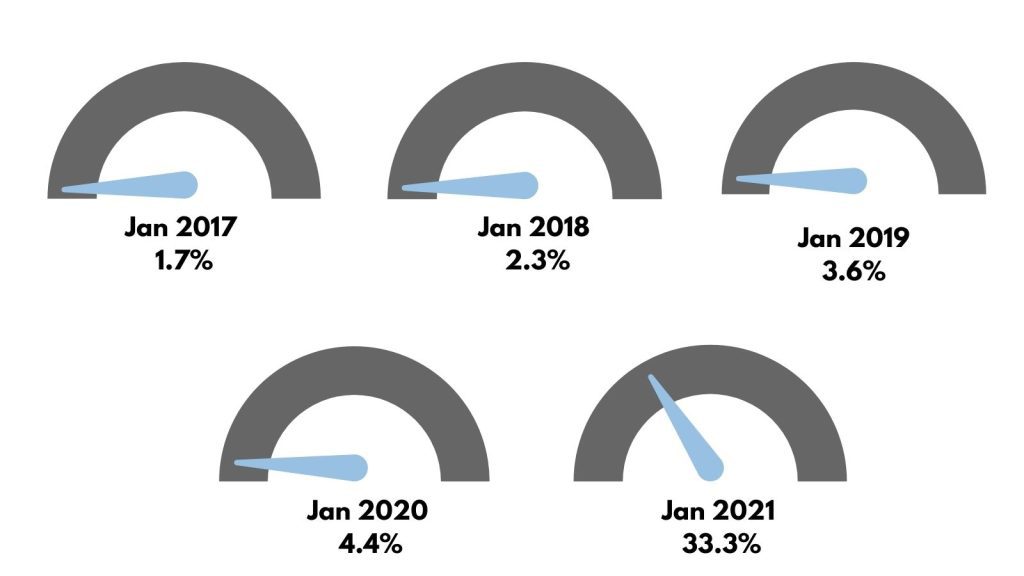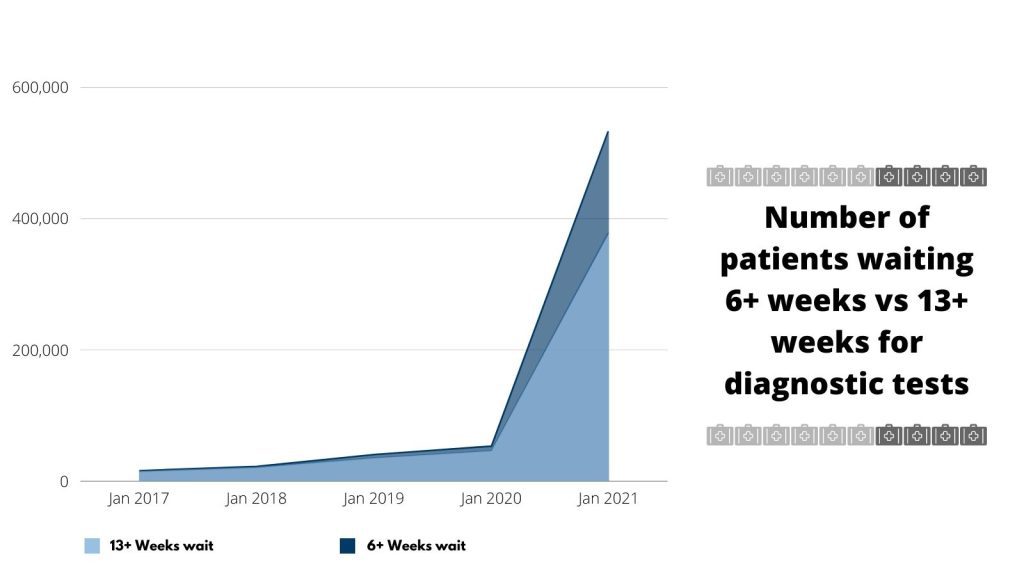Understanding NHS waiting times

If you have ever been referred for treatment on the NHS, you may have experienced a waitlist. While this can be difficult, wait times are expected when our national health services faces strains and shortages, and more recently, COVID-19. Understanding the NHS wait times can be confusing or difficult, so we have outlined here the various different contributing factors.
At present, waiting times have reached a peak in the UK. The pandemic has unfortunately caused waiting times to grow. The number of people waiting for treatment on the NHS has risen by a fifth. The IFS states that around 5.3 million people were waiting for treatment as recently as May 2021.
This is expected to increase even further with ever changing COVID-19 circumstances and lockdown challenges.
In order to really understand the waiting times in the NHS, we have analysed some of the data available from the NHS on their waiting times for diagnostic treatments. The following graphs highlight different areas of the waiting times challenges we currently face.
Total waiting times

This graph highlights the total number of patients waiting for diagnostic tests. This data is based upon 15 specific common diagnostic tests. The data also encompasses a variety of different healthcare providers. Such as NHS Trusts, NHS Foundation Trusts and Independent Sector Providers. As you can see, by 2021 there was a sharp rise in waiting numbers, extending to over 1 million patients.
Wait times over six weeks

The second graph reveals the percentage of patients who have waited over 6 weeks for diagnostic tests and procedures. Similarly to the previous graph, in January 2021 there are the most patients waiting over 6 weeks. With the rest of the years falling around the same percentage. This percentage has crept up year upon year, with the pandemic massively accelerating the wait times.
Comparative waiting times

While the NHS of course aims to see patients as soon as possible, this is not always the case. Local resources, severity, priority, availability and many other factors determine waiting times. Here we can see the difference between patients waiting 6+ weeks and 13+ weeks.
As evidenced, in January 2021 there was another shocking rise in both types of wait times. However, the NHS still managed to ensure that less people waited 13+ weeks than waited 6+, despite the many challenges they are facing currently. As for the other years, the difference between the two wait times is not so stark. It is also generally much lower than 2021.
Planned and unplanned diagnostic testing
![Number of planned vs unscheduled diagnostic tests [chart]](https://b2270281.smushcdn.com/2270281/wp-content/uploads/2021/09/Add-a-subheading-1-1024x576.jpg?lossy=1&strip=1&webp=1)
Interestingly, many of us forget the urgent and unforeseen challenges the NHS face. This image highlights the planned vs. unscheduled tests that occurred in the month of January across several years. As we can see, each year, the number of unplanned procedures exceeds those that were planned. This is for a number of reasons, but could be a big contribution to longer waiting times. Emergencies and prioritising are big concerns for the NHS.
Consultant-led referrals to treatment waiting times
Referred to as “incomplete pathways”, the statistics here are for patients still waiting to begin treatment by the end of the month being recorded. In this case, January 2021. In this time period, there were 4,592,675 incomplete pathways. Meaning those referred have not yet received treatment for their condition. Furthermore, the average wait time in these cases is 12 weeks.
We can likely attribute to the constantly changing COVID-19 situation, whereby hospital admission regularly reduce and increase periodically throughout the year.
Recent NHS waiting times
Recent data from July 2021 is similar to that of January 2021, with COVID-19 variants and lockdown coming to an end, waiting times have once again suffered. Here are some key statistics from the referrals to treatment data. (Note: this data refers to England only).
- 68.3% of patients received treatment within 18 weeks, however, the NHS standard is 92%.
- By the end of July 2021, half of patients were waiting less than 11 weeks.
- 92 out of 100 patients were waiting less than 44 weeks.
- The amount of patients waiting to start treatment after referral was 5,606,724.
As waiting times increase due to the demands of budget cuts, staff shortages and COVID-19, it is important that we have reasonable expectations. Our NHS is a wonderful gift to the UK, and while they face difficulties and struggles, as do their patients, we should all take into account the hard work given by healthcare providers during this difficult period of time.
 Read more
Read more
The meaning of green: Why do doctors wear green scrubs?
How many hospital beds are there in the UK?
Sources
- https://www.england.nhs.uk/statistics/statistical-work-areas/rtt-waiting-times/rtt-data-2021-22/
- https://www.england.nhs.uk/statistics/statistical-work-areas/rtt-waiting-times/rtt-data-2020-21/
- https://www.nhs.uk/nhs-services/hospitals/guide-to-nhs-waiting-times-in-england/
- https://www.england.nhs.uk/statistics/statistical-work-areas/diagnostics-waiting-times-and-activity/monthly-diagnostics-waiting-times-and-activity/
- https://ifs.org.uk/publications/15557



